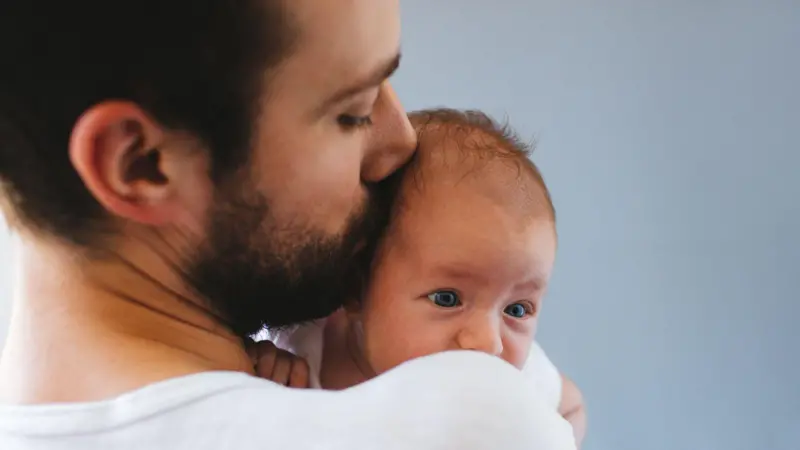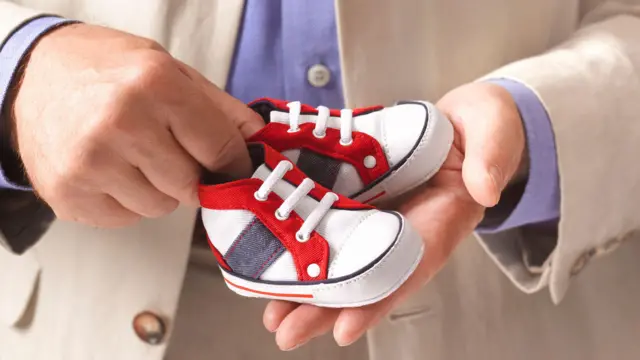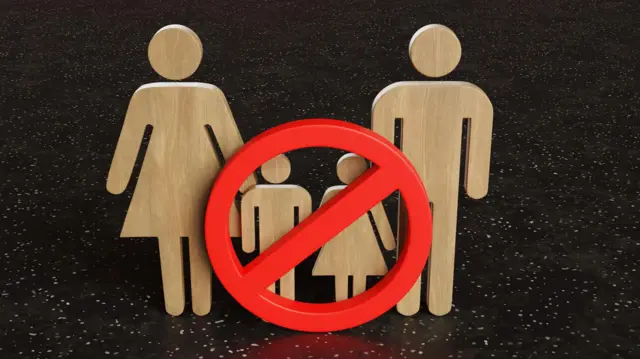
The crucial role of men in the decline in the global birth rate
When now Vice President-elect JD Vance made a comment about childless women (referring to them as cat ladies ), he conjured up an image of educated, urbane, career-minded women.
But the picture of who is childless is changing. Recent research has found that men are more likely to be unable to have children even if they want them, particularly those with lower incomes.
A 2021 study in Norway found that the rate of childless men was 72% among the bottom 5% of earners, but only 11% among the top earners – a gap that had increased by almost 20 percentage points over the past 30 years.
Robin Hadley is one of those men who wanted to have a child but had a hard time getting one. He didn’t go to university and became a photography technician at a university laboratory in Manchester, UK. At 30, Hadley was desperate to become a father.
He was single, having been married and divorced in his early 20s, and was struggling to pay his mortgage, leaving him with little disposable income. Since he couldn’t afford to go out much, dating was a challenge.
When her friends and colleagues became parents, she felt a sense of loss.
“Things like birthday cards for kids or fundraisers for friends’ new babies remind you of what you’re not and what you’re expected to be. There’s pain associated with that,” she says.
His experience inspired him to write a book in which he analyses why, today, more and more men like him who want to be fathers fail to do so.
As he did his research, he realized that, as he puts it, he had been affected by “all the factors that influence fertility outcomes: economics, biology, timing, and relationship choice .”

Image source,Getty Images
She also noted that childless men were absent from most studies on aging and reproduction, as well as from national statistics.
Hadley interviewed other British men who were childless and wanted them. They also expressed sadness and loss, and told him that they were missing “something” in their lives.
Recent figures from the UK Office for National Statistics showed births in England and Wales fell to an average of 1.44 per woman, the lowest rate on record. The US birth rate is at an all-time low, while China recorded its first population decline in 60 years in 2022.
The proportion of childless people is increasing in almost every country in the world. Statistics are collected differently in each part of the world and are difficult to compare, but childless rates are particularly high in East Asia.
Increase in “social infertility”
For some it is a choice. For others, it is the result of biological infertility.
For many more, like Hadley, it is something more, a confluence of factors, which may include lack of resources, financial difficulties or not having met the right person at the right time.
Some speak of ” social infertility . “
Anna Rotkirch, a sociologist and demographer at the Finnish Demographic Research Institute who has been studying fertility intentions in Europe and Finland for more than 20 years, says there may be something else at play: She notes that there has been a profound change in the way we view children .
Like marriage, having a child was once considered a momentous event, something young people did as they embarked on adult life.
Now, Rotkirch says, it is seen as a culminating event, something you do after other goals have been achieved.

Image source,Getty Images
Outside of Asia, Finland has one of the highest rates of childlessness in the world.
In the 1990s and early 2000s, however, the country was known for combating declining fertility with world-leading pro-child policies.
Parental leave is generous, childcare is affordable, and men and women do a more equal share of housework.
Since 2010, however, fertility rates in the country have fallen by almost a third.
“People of all classes seem to think that having a child adds uncertainty to their lives,” Rotkirch explains.
In Finland, wealthier women are the least likely to be involuntarily childless, while low-income men are the most likely.
This is a big change from the past.
Historically, people from poorer families tended to enter adulthood earlier: they left school, got a job and started a family at an earlier age.
This trend is also occurring in other parts of Europe.
“Now it’s the most disadvantaged people who are least likely to start a family because they can’t afford to,” adds Bernice Kuang, a demographer at the University of Southampton in the UK.
When Kuang surveyed the fertility intentions of young Britons, he was surprised by the results.
Twice as many 18- to 25-year-olds (15%) now say they will never have children compared with 15 years ago (7-8%). Many more are unsure.
Of those who have not yet had children, more than half say they do not want to or are unsure.
“It’s a big change from previous generations,” he says. Those who responded negatively tended to be the most economically insecure.
When young people felt they had a lower standard of living than their parents, they were less likely to want to have a child.
Crisis of masculinity
For men, financial uncertainty has a major impact on childlessness. Sociologists call this the “selection effect” : women tend to look for someone from their same or higher social class when choosing a partner.

Image source,Getty Images
“I realise I was playing in a different league, intellectually and in terms of confidence,” says Robin Hadley. “I think, on reflection, the selection effect might have been a factor.”
In his late 30s, he met his current wife. By the time they talked about having children, they were already in their 40s and it was too late. But he says she helped him gain confidence to go to college and get his PhD. “I wouldn’t be where I am today if it weren’t for her.”
Women outnumber men in education in 70 percent of the world’s countries, giving rise to what Yale sociologist Marcia Inhorn calls the “mating gap . “
In Europe, this means that men without a university degree are the group most likely to remain childless.
Invisible demographics
Like most countries, the UK does not have reliable data on male fertility, as it only takes into account the mother’s fertility history when registering a birth.
This means that childless men do not exist as a recognized “category.”
Some Nordic countries, however, record both data.
The 2021 Norwegian study found that a significant number of men were being “left behind” , noting that “childlessness is higher among poorer men” , and that “this inequality in fertility has widened over time”.
According to its authors, “although much is already known about female fertility… relatively little is known about male fertility.”
The role of men in declining birth rates is often overlooked, says Vincent Straub, who studies male health and fertility at the University of Oxford.

Image source,Getty Images
Gender roles
Martha Bao is 30 years old, lives in Shanghai and works in human resources. She is part of a rapidly growing group of young Chinese women who are saying no to motherhood.
In 2019, 4.5% of people under 30 in China did not want to have children; two years later, that figure had more than doubled to 9.5%.
These statistics do not differentiate between women and men, but Martha says that most of her friends do not want to have children, while all men do.
Not surprising, she says, when the burden of childcare in China falls squarely on mothers.
“I think raising a child means taking on a lot of responsibilities and I don’t want to take them on. I want to be free,” she explains.

Image source,Getty Images
What can be done?
Another reason for the declining birth rate, Straub and Hadley say, may be that the conversation about infertility is almost entirely focused on women. Policies aimed at combating it miss half the problem.
Straub believes we should focus on fertility as a male health issue and discuss the benefits of paternal care.
“In the European Union, only one in 100 men interrupts his career to look after a child; in the case of women, it is one in three,” she says.
And this is despite the countless pieces of evidence that raising a child is good for men’s health.
“We need better data,” says Robin Hadley. Until we record male fertility, we will not be able to fully understand it and the impact it has on their physical and mental health.
And the invisibility of men in fertility debates goes beyond records. While there is now more awareness that young women need to think about their fertility, it is not a conversation that is being had among young men.
Men also have a biological clock , says Hadley, pointing to research showing that sperm effectiveness declines after age 35. And that’s something she thinks more young men need to understand.
So making this invisible group visible is one way to address social infertility. And another might be to broaden the definition of parenthood.
All researchers who have discussed childlessness have pointed out that childless people play a key role in raising children.

Image source,Getty Images
Behavioural ecologists call this alloparenting, explains Anna Rotkirch. For much of our evolution, a baby had more than a dozen caregivers.
One of the childless men Hadley spoke to in her research described a family he met regularly at his local football club. For a school project, the two boys needed a grandparent. But they didn’t have one.
He became their surrogate grandfather for three years, and afterward, when they saw him on the soccer field, they would say, “Hi, Grandpa.” It was wonderful to feel recognized in that way, he says.
“I think most childless people are involved in this kind of caregiving, they’re just invisible,” Rotkirch says.
“They don’t appear in birth records, but they are really important.”







1 thought on “The crucial role of men in the decline in the global birth rate”